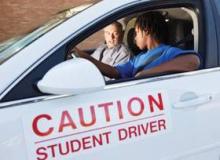Car crashes are the leading cause of death among teens, accounting for one-third of deaths in this age group in the United States.
The good news is that the rate of motor vehicle deaths among adolescents has been on the decline over the past decade in most U.S. states. The success of efforts by state and local governments in bringing down traffic deaths, especially among teens, is rated among the top 10 public health achievements of the past decade, according to the Centers for Disease Control and Prevention (MMWR, 2011;60:619-23).
The CDC analyzed data from the Fatality Analysis Report System to assess crash death risk among teens. The rate for drivers aged 16 or 17 years involved in a fatal car accident declined approximately 38%, from 27.1 per 100,000 population in 2004 to 16.7 in 2008 (MMWR 2010;59:1329-34). The decline as been attributed to a variety of factors including increased use of seat belts and decreased rates of drunk driving among teens, but also changing driver behavior brought about by training and other public health interventions.
Several innovative approaches hold promise for making teens safer drivers, according to Dr. Beth Ebel, director of the Harborview Injury Prevention & Research Center and a physician at Seattle Children’s Hospital, Seattle.
"We know that learning to drive is risky," she commented. Despite the decline in fatal crashes among teens, "this still remains such a high risk for kids that we really need to consider how we can do better."
Research is helping to sort out what works – and what doesn’t – for reducing teen drivers’ risk to themselves and others. For example, "policy and frameworks that work for adults work for kids, and more so with seat belt and alcohol and texting laws," said Dr. Ebel.
Driver education has been found ineffective, Dr. Ebel said. In fact, a 1999 study associated such education with an increased risk of motor vehicle crashes (Am. J. Prev. Med. 1999;16:40-6).
"This isn’t because driver’s ed is teaching you to drive in a risky way," she explained. "Driver’s ed gives you early exposure to a vehicle before your frontal lobe and everything else has fully matured. So it basically gets you in the vehicle at a younger age."
On the other hand, graduated driver licensing (GDL), in which teens’ driving privileges are slowly expanded, has been a success. This legislation has three components – a restriction on passengers in the vehicle, a restriction on nighttime driving, and a zero-tolerance policy for the combination of alcohol and driving – the specifics of which vary by state.
Implementation of GDL has been associated with a 25% reduction in numbers of crashes (JAMA 2001;286:1593-8), "so we should do this," Dr. Ebel recommended. "It gives parents some guidance on what to advise their kids. GDL’s effect isn’t that it really makes you a safer driver; it tends to reduce driving exposure."
It is difficult to enforce because law enforcement officers can’t reliably identify teen drivers by appearance. "So GDL is working primarily through parents and kids knowing what the law is and being willing to implement that," she said. "And that’s of course not always going to work for some of the kids at highest risk."
Parent-teen driving contracts, such as one used in the Checkpoints Program, an education-based intervention, also have shown promise. It’s a chance to sit down with your kids, like in other areas ... and discuss what your expectations are when they are in the vehicle, Dr. Ebel commented at the annual meeting of the Society for Adolescent Health and Medicine in Seattle.
Parents participating in the program put more limits on their teens’ driving privileges, although risky driving and rates of violations and crashes are not reduced (J. Safety Res. 2006;37:9-15). "But I think having that discussion is probably a good starting point," she said.
Additional help in improving the safety of teen drivers may come from several novel technologies. One is event-triggered video, in which a camera installed on the rearview mirror captures data both inside and outside the car if, for example, the driver slams on the brakes or swerves. It is available free through some auto insurance companies.
"[Driving] still remains such a high risk for kids that we really need to consider how we can do better."



